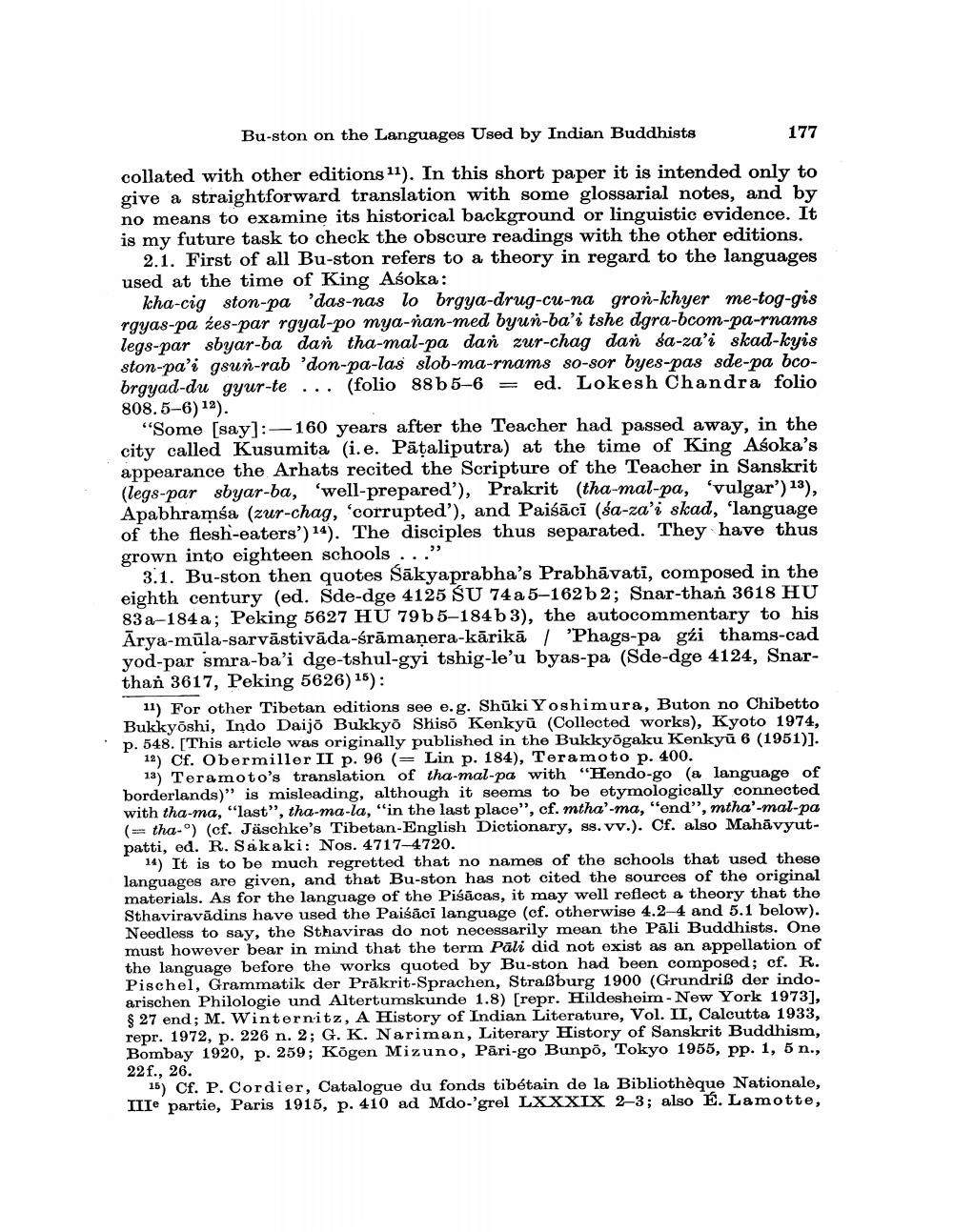Book Title: Buston On Languages Used By Indian Buddhists At Schismatic Period Author(s): Akira Yuyama Publisher: Akira Yuyama View full book textPage 3
________________ 177 Bu-ston on the Languages Used by Indian Buddhists collated with other editions 11). In this short paper it is intended only to give a straightforward translation with some glossarial notes, and by no means to examine its historical background or linguistic evidence. It is my future task to check the obscure readings with the other editions. 2.1. First of all Bu-ston refers to a theory in regard to the languages used at the time of King Aśoka: kha-cig ston-pa 'das-nas lo brgya-drug-cu-na gron-khyer me-tog-gis rgyas-pa tes-par rgyal-po mya-nan-med byun-ba'i tahe dgra-boom-pa-rnams legs-par abyar-ba dan tha-mal-pa dan zur-chag dan da-za's skad-kyis ston-pa'i geun-rab 'don-pa-las slob-ma-rnams so-sor byes-pas sde-pa bcobrgyad-du gyur-te... (folio 88b5-6 ed. Lokesh Chandra folio 808.5-6)1). "Some [say]:-160 years after the Teacher had passed away, in the city called Kusumita (i.e. Päțaliputra) at the time of King Aśoka's appearance the Arhats recited the Scripture of the Teacher in Sanskrit (legs-par abyar-ba, 'well-prepared'), Prakrit (tha mal-pa, 'vulgar') ), Apabhramsa (zur-chag, 'corrupted'), and Paisaci (da-za'i skad, 'language of the flesh-eaters') 14). The disciples thus separated. They have thus grown into eighteen schools 3.1. Bu-ston then quotes Sakyaprabha's Prabhavati, composed in the eighth century (ed. Sde-dge 4125 SU 74a5-162b2; Snar-than 3618 HU 83a-184a; Peking 5627 HU 79b5-184b3), the autocommentary to his Arya-müla-sarvästiväda-érämanera-kärikā 'Phags-pa gźi thams-cad yod-par smra-ba'i dge-tshul-gyi tshig-le'u byas-pa (Sde-dge 4124, Snarthan 3617, Peking 5626) 15): 11) For other Tibetan editions see e. g. Shuki Yoshimura, Buton no Chibetto Bukkyōshi, Indo Daijo Bukkyō Shisō Kenkyu (Collected works), Kyoto 1974, p. 548. [This article was originally published in the Bukkyōgaku Kenkyu 6 (1951)]. 12) Cf. Obermiller II p. 96 (= Lin p. 184), Teramoto p. 400. 13) Teramoto's translation of tha-mal-pa with "Hendo-go (a language of borderlands)" is misleading, although it seems to be etymologically connected with tha-ma, "last", tha-ma-la, "in the last place", cf. mtha'-ma, "end", mtha'-mal-pa (tha-) (cf. Jäschke's Tibetan-English Dictionary, ss. vv.). Cf. also Mahāvyutpatti, ed. R. Sakaki: Nos. 4717-4720. 14) It is to be much regretted that no names of the schools that used these languages are given, and that Bu-ston has not cited the sources of the original materials. As for the language of the Pisacas, it may well reflect a theory that the Sthaviravadins have used the Paiśaci language (cf. otherwise 4.2-4 and 5.1 below). Needless to say, the Sthaviras do not necessarily mean the Pāli Buddhists. One must however bear in mind that the term Pali did not exist as an appellation of the language before the works quoted by Bu-ston had been composed; cf. R. Pischel, Grammatik der Prakrit-Sprachen, Straßburg 1900 (Grundriß der indoarischen Philologie und Altertumskunde 1.8) [repr. Hildesheim - New York 1973], § 27 end; M. Winternitz, A History of Indian Literature, Vol. II, Calcutta 1933, repr. 1972, p. 226 n. 2; G. K. Nariman, Literary History of Sanskrit Buddhism, Bombay 1920, p. 259; Kōgen Mizuno, Pari-go Bunpo, Tokyo 1955, pp. 1, 5 n., 22f., 26. 15) Cf. P. Cordier, Catalogue du fonds tibétain de la Bibliothèque Nationale, IIIe partie, Paris 1915, p. 410 ad Mdo-'grel LXXXIX 2-3; also É. Lamotte,Page Navigation
1 2 3 4 5 6 7
